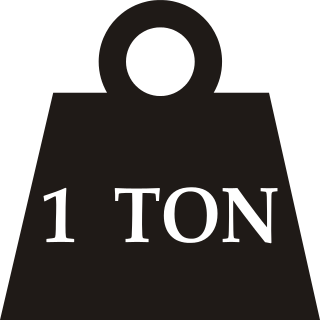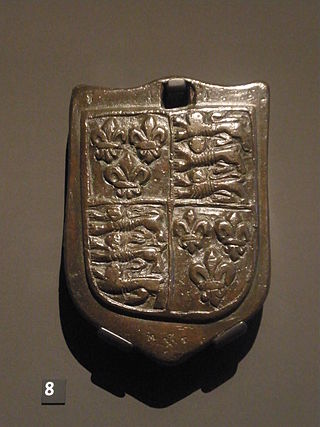Related Research Articles

A hogshead is a large cask of liquid. It refers to a specified volume, measured in either imperial or US customary measures, primarily applied to alcoholic beverages, such as wine, ale, or cider.

The pound or pound-mass is a unit of mass used in both the British imperial and United States customary systems of measurement. Various definitions have been used; the most common today is the international avoirdupois pound, which is legally defined as exactly 0.45359237 kilograms, and which is divided into 16 avoirdupois ounces. The international standard symbol for the avoirdupois pound is lb; an alternative symbol is lbm, #, and ℔ or ″̶.

Ton is any of several units of measure of mass, volume or force. It has a long history and has acquired several meanings and uses.
The long ton, also known as the imperial ton or displacement ton, is a measurement unit equal to 2,240 pounds (1,016.0 kg). It is the name for the unit called the "ton" in the avoirdupois system of weights or Imperial system of measurements. It was standardised in the 13th century. It is used in the United States for bulk commodities.

The hundredweight, formerly also known as the centum weight or quintal, is a British imperial and United States customary unit of weight or mass. Its value differs between the United States customary and British imperial systems. The two values are distinguished in American English as the short and long hundredweight and in British English as the cental and imperial hundredweight.

The stone or stone weight is an English and British imperial unit of mass equal to 14 avoirdupois pounds (6.35 kg). The stone continues in customary use in the United Kingdom and Ireland for body weight.
The slug is a derived unit of mass in a weight-based system of measures, most notably within the British Imperial measurement system and the United States customary measures system. Systems of measure either define mass and derive a force unit or define a base force and derive a mass unit. A slug is defined as a mass that is accelerated by 1 ft/s2 when a net force of one pound (lbf) is exerted on it.
The tun is an English unit of liquid volume, used for measuring wine, oil or honey. Typically a large vat or vessel, most often holding 252 wine gallons, but occasionally other sizes were also used. The modern tun is about 954 litres.
English units were the units of measurement used in England up to 1826, which evolved as a combination of the Anglo-Saxon and Roman systems of units. Various standards have applied to English units at different times, in different places, and for different applications.

The earliest recorded systems of weights and measures originate in the 3rd or 4th millennium BC. Even the very earliest civilizations needed measurement for purposes of agriculture, construction and trade. Early standard units might only have applied to a single community or small region, with every area developing its own standards for lengths, areas, volumes and masses. Often such systems were closely tied to one field of use, so that volume measures used, for example, for dry grains were unrelated to those for liquids, with neither bearing any particular relationship to units of length used for measuring cloth or land. With development of manufacturing technologies, and the growing importance of trade between communities and ultimately across the Earth, standardized weights and measures became critical. Starting in the 18th century, modernized, simplified and uniform systems of weights and measures were developed, with the fundamental units defined by ever more precise methods in the science of metrology. The discovery and application of electricity was one factor motivating the development of standardized internationally applicable units.
The wey or weight was an English unit of weight and dry volume by at least 900 AD, when it began to be mentioned in surviving legal codes.
The last was a Dutch unit of mass, volume, and number, and a large English unit of weight, mass, volume, and number. It referred to standardized amounts of ships' lading and varied by commodity and over time.
A firkin is a unit of volume or mass used in several situations. Its etymology is likely to be from the Middle English ferdekyn, probably from the Middle Dutch diminutive of vierde 'fourth'. Firkin also describes a small wooden cask or tub for butter, lard, liquids, or fish.
Ship load is a United Kingdom unit of weight for coal equal to 20 keels or 949,760 pounds (430,800 kg).
The sack was an English unit of weight or mass used for coal and wool. It has also been used for other commodities by weight, commodities by volume, and for both weight and volume in the United States.
A number of different units of measurement were historically used in Cyprus to measure quantities like length, mass, area and capacity. Before the Metric system, the Imperial system was used. In between 1986-1988, metric system was adopted in Cyprus.
Traditional Greek units of measurement were standardized and used in modern Greece before and alongside the adoption of the metric system in 1836. Metric units were finally made legally compulsory in 1922.
A number of units of measurement were used in Iceland to measure length, mass, area, capacity, etc. Since 1907, the metric system has been compulsory in Iceland.
A number of units of measurement were used in South Africa to measure quantities like length, mass, capacity, etc. The Imperial system of measurements was made standard in 1922 and the metric system was adopted in 1961.
References
- 1 2 3 4 Cardarelli, François (2003). Encyclopaedia of Scientific Units, Weights and Measures . London: Springer. pp. 46. ISBN 978-1-4471-1122-1.
- ↑ "FootRule - Old English Commerce Measures". www.footrule.com. Retrieved 2019-05-17.
- ↑ Gyllenbok, Jan (2018-04-12). Encyclopaedia of Historical Metrology, Weights, and Measures. Birkhäuser. ISBN 9783319667126.